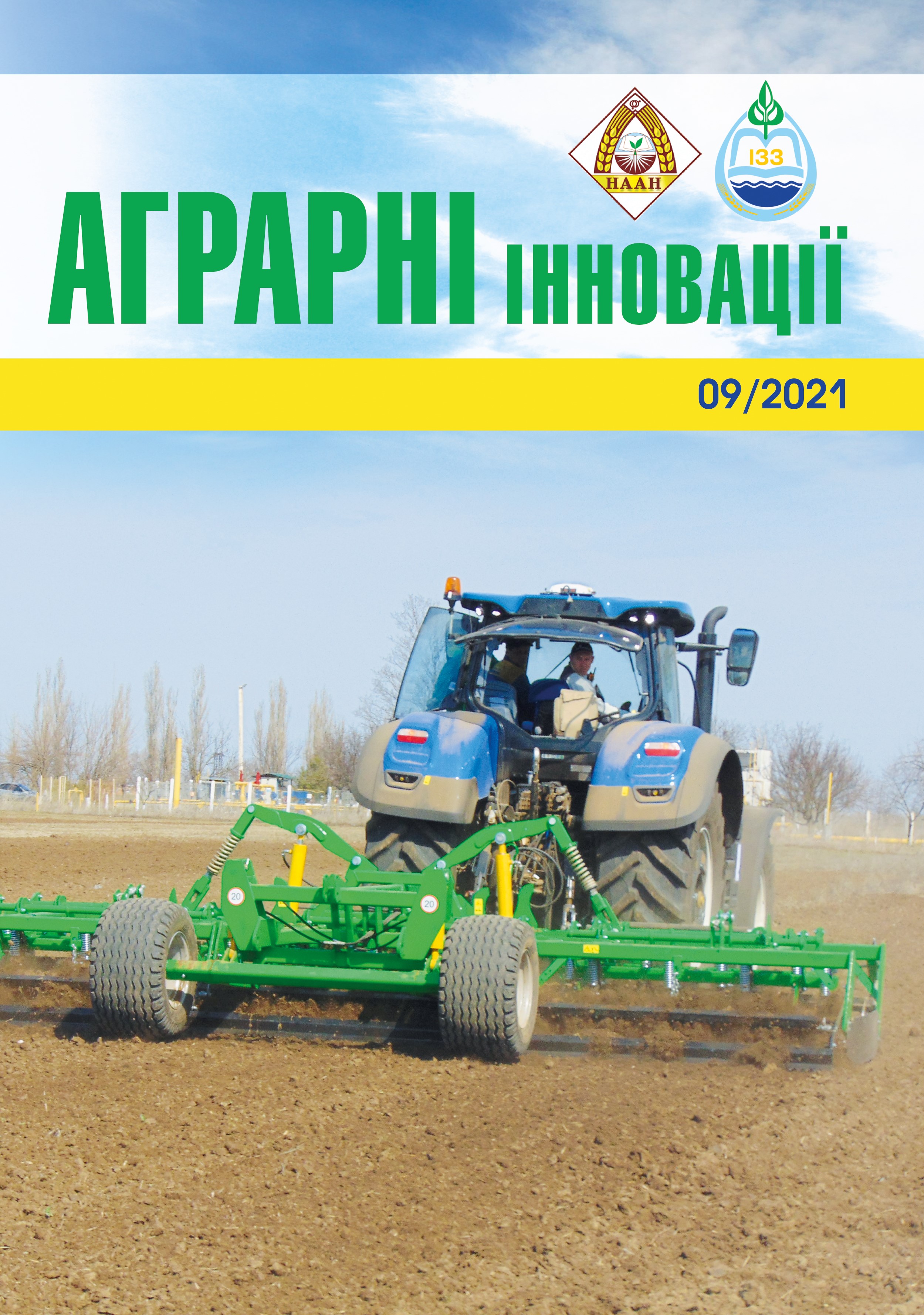Gamma-rays depression consequences for winter wheat after gamma-rays action (Triticum aestivum L.)
Abstract
The problem of mutagenic depression due to the reduction in the volume of material for further genetic improvement and narrowing the range of doses used is key to experimental mutagenesis. Purpose. The aim of the experiments was to show the presence and specificity of post-depression depression of a wide range of doses of gamma rays in winter wheat varieties adapted for the North of the Steppe of Ukraine in terms of ontogenesis, morphometry, yield. Methods: The experiments used seeds of winter wheat varieties of local breeding Spivanka and Commerciyna, irradiated with gamma rays in doses of 100, 150, 200, 250, 300 Gy. Control was dry seeds. The parameters of germination and survival, the passage of the main phases of ontogenesis in winter wheat plants of local varieties (Commerciyna and Spivanka) in the first generation were studied. The influence of mutagenic depression on indicators of yield structure (morphometry of mature plants) was established and the level of their variability was established. Results. It was found that higher depression on all studied traits appeared in the commercial variety, except in moderate doses in some cases, which indicates the specificity of the interaction of depressive activity of gamma rays with genotypes of certain varieties and the complex nature of depressive effects at the body level. The most informative indicators of mutagenic depression at the first generation of winter bread wheat varieties were: germination and survival of pollen, pollen fertility and yield structure indicators such as plant height, grain weight from the main spike, grain weight from the plant, weight of thousands grains. All of these with high level of significance are correlated with the mutagen dose rate. Findings. Genotypes of varieties of local breeding (Commerciyna and Spivanka) were sensitive to the action of gamma-rays, which manifested itself in the semi-lethality of even the initial, moderate doses (100 Gy.). Analysis of variance showed that the formation of indicators of yield structure was influenced primarily by the factor mutagen dose, then genotype of the original variety, but the second factor was quite significant in the case of these varieties. It was found that there may be a rapid decrease in certain parameters in the first generation when reaching certain dose limits (200 -250 Gy), and these doses are determined by the genotype of the subject of mutagenic action.
References
2. Asif J. (2020). Effect of different pre-treatments on seed germination of Prosopis juliflora and Dalbergia sissoo: a step towards mutation breeding, Journal of forest science, 66, 80–88. doi: https://doi.org/10.17221/64/2019-JFS.
3. Çelik Ö., Ekşioğlu A. & Akdaş E.Y. (2018). Transcript profiling of salt tolerant tobacco mutants generated via mutation breeding, Gene Expression Patterns, 29, 59–64. doi: 10.1016/j.gep.2018.05.001.
4. Chen S., Gao R., Wang H., Wen M., Xiao J, Bian N., Zhang R., Hu W., Cheng S., Bie T. & Wang X. (2015). Characterization of a novel reduced height gene (Rht23) regulating panicle morphology and plant architecture in bread wheat, Euphytica, 203, 583–594. doi: 10.1007/s10681-014-1275-1.
5. Essam F., Badrya M. & Aya M. (2019). Modeling and forecasting of wheat production in Egypt, Advances and Applications in Statistics, 59(1), 89–101. doi: http://dx.doi.org/10.17654/AS059010089.
6. Fellahi Z., Hannachi A., Oulmi A. & Bouzerzour H. (2018). Analyse des aptitudes générale et spécifique à la combinaison chez le blé tendre (Triticum aestivum L.), Revue Agriculture, 9(1), 60–70.
7. Gasperini D., Greenland A., Hedden P., Dreos R., Harwood W. & Griffiths S. (2012). Genetic and physiological analysis of Rht8 in bread wheat: an alternative source of semi-dwarfism with a reduced sensitivity to brassinosteroids, Journal of Experimental Botany, 63, 4419–4436. doi: 10.1093/jxb/ers138.
8. Hallajian M.T. (2016). Mutation Breeding and Drought Stress Tolerance in Plants, Drought Stress Tolerance in Plants, 2, 359–383. doi: 10.1007/978-3-319-32423-4_13.
9. Hiroyasu Y. (2018). Mutation breeding of ornamental plants using ion beams, Breeding Science, 68(1), 71–78. doi: 10.1270/jsbbs.17086
10. Hongjie Lia, Timothy D. M., Mc Intoshc R.A. & Yang Z. (2019). Breeding new cultivars for sustainable wheat production, The Crop Journal, 7(6), 715–717. doi: https://doi.org/10.1016/j.cj.2019.11.001.
11. Kolakar S.S., Nadukeri S., Jakkeral S.A., Hanumanthappa M. & Gangaprasad S. (2018). Role of mutation breeding in improvement of medicinal and aromatic crops: Review, Journal of Pharmacognosy and Phytochemistry, SP3, 425–429. doi: http://dx.doi.org/10.4171/2267- 0412.100e108.
12. Li H.J., Timothy D.M., Mc Intoshc R.A. & Zhou Y. (2019). Wheat breeding in northern China: achievements and technical advances, The Crop Journal, 7(6), 718–729. doi: https://doi.org/10.1016/j.cj.2019.09.003.
13. Nazarenko M. (2015). Negativnyie posledstviya mutagennogo vozdeystviya [Peculiarities of negative consequences of mutagen action], Ecological Genetics, 13(4), 25–26. (in Russian). doi: https://doi.org/10.17816/ecogen13425-26
14. Naveed A., Nazir A., Abdu, H., Raza S. & Muhammad A. (2015). Mutation breeding: a tool to improve wheat yield and yield components, Life Science, 9 (1), 3274–3279.
15. Saif-u-Malook S.A., Qaisarani M.K., Shabaz H., Ahmed M., Nawaz M. & Qurban A. (2015). Mutation breeding approach to breed drought tolerant maize hybrids, International Journal of Biosciences, 6(2), 427–436. doi: 10.12692/ijb/6.2.427-436.
16. Shah F., Adnan M. & Basir A. (2018). Global Wheat Production. Intechopen, London. doi: 10.5772/intechopen.72559
17. Shu Q.Y., Forster B.P. & Nakagava H., (2013). Plant mutation breeding and biotechnology. CABI publishing, Vienna. doi: 10.1079/9781780640853.0000.
18. Spencer-Lopes M.M., Forster B.P. & Jankuloski L. (2018). Manual on mutation breeding. Third edition. Food and Agriculture Organization of the United Nations, Rome.
19. Xicun D., Xia Y., & Wenjian L. (2016). Plant Mutation Breeding with Heavy Ion Irradiation at IMP, Journal of Agricultural Science, 8(5), 34–41. doi: 10.5539/jas.v8n5p34.






